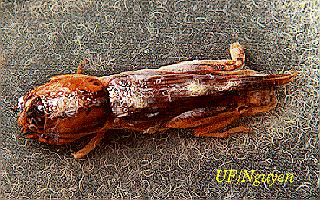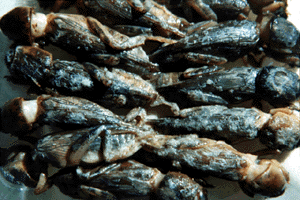

The most important insect pests of turf and pastures in Florida are mole crickets. And their damage is not restricted to grasses. Their feeding and tunneling also destroy seedlings of vegetables, ornamentals, and tobacco. Insecticides commonly applied to control mole crickets in lawns, golf courses, and seed beds are expensive and not always effective. In pastures there is no control that is economically feasible; yet without control, stands of pasture grasses are frequently so reduced as to require replanting. The annual cost of mole crickets to Floridians is no less than $30 million.
In 1978, in response to increasing concerns of cattlemen, turf managers, and home owners, the Institute of Food and Agricultural Sciences of the University of Florida intensified its research on mole crickets, the genus Scapteriscus.
The research on using entomopathogenic nematodes in controlling mole crickets began from 1983 by conducting a survey in attempts to find mole crickets infected with steinernematid or heterorhabditid nematodes. About two thousand mole crickets from Alachua County, Florida, and a few from other counties in the state, were collected and held until they died. Three to five days after they died the cadavers were dissected and examined for steinernematid or heterorhabditid nematodes. No heterorhabditids were found and only four were infected with steinernematids. One of those was infected with S. glaseri, and three were infected with S. carpocapsae. Progeny of these nematodes were used in laboratory experiments to infect other mole crickets. Neither of the species infected mole crickets well, or reproduced well in those that became infected. In 1985, a steinernematid nematode, parasite of mole crickets, was brought from Uruauay to Florida. That nematode, which was described as a new species, Steinernema scapterisci (Nguyen and Smart, 1990), appears to be a major factor limiting populations of mole crickets in South America. The nematode was never found in Florida before the release in 1985. When the nematode was applied to small plots in 1985 in Alachua County, Florida, a maximum of 40% infection of those mole crickets was collected in pitfall traps during a 24-hour collection period immediately after application. These plots were sampled monthly for 5 years and, on average about 10% of the mole crickets trapped were infected. That 10%, coupled with the higher initial infection, was sufficient to reduce populations of nymphal mole crickets collected in pitfall traps by about 85% after one year and 95% or more there after. The nematode persisted in the plots for at least the duration of our 5-year sampling period. The effectiveness of the nematode is due in part to the fact that the mole crickets have only one generation per year in North Florida and the nematode, theoretically, could produce a new generation every 10 days for approximately 8 months of the year.
Since 1985 Steinernema scapterisci has been detected in mole crickets collected from several other sites in Alachua county, spread from our original release sites, undoubtedly by mole crickets during the flight period after they became infected but were still capable of flight. Up to November, 1998, about 10-30 % of mole crickets collected in Alachua county, Florida have been infected with S. scapterisci.
In 1990 and 1991, the nematode was released in pastures in 6 different counties and on nearly 30 golf courses in Florida. It has become established and has reduced populations of mole crickets in all of the pastures.
